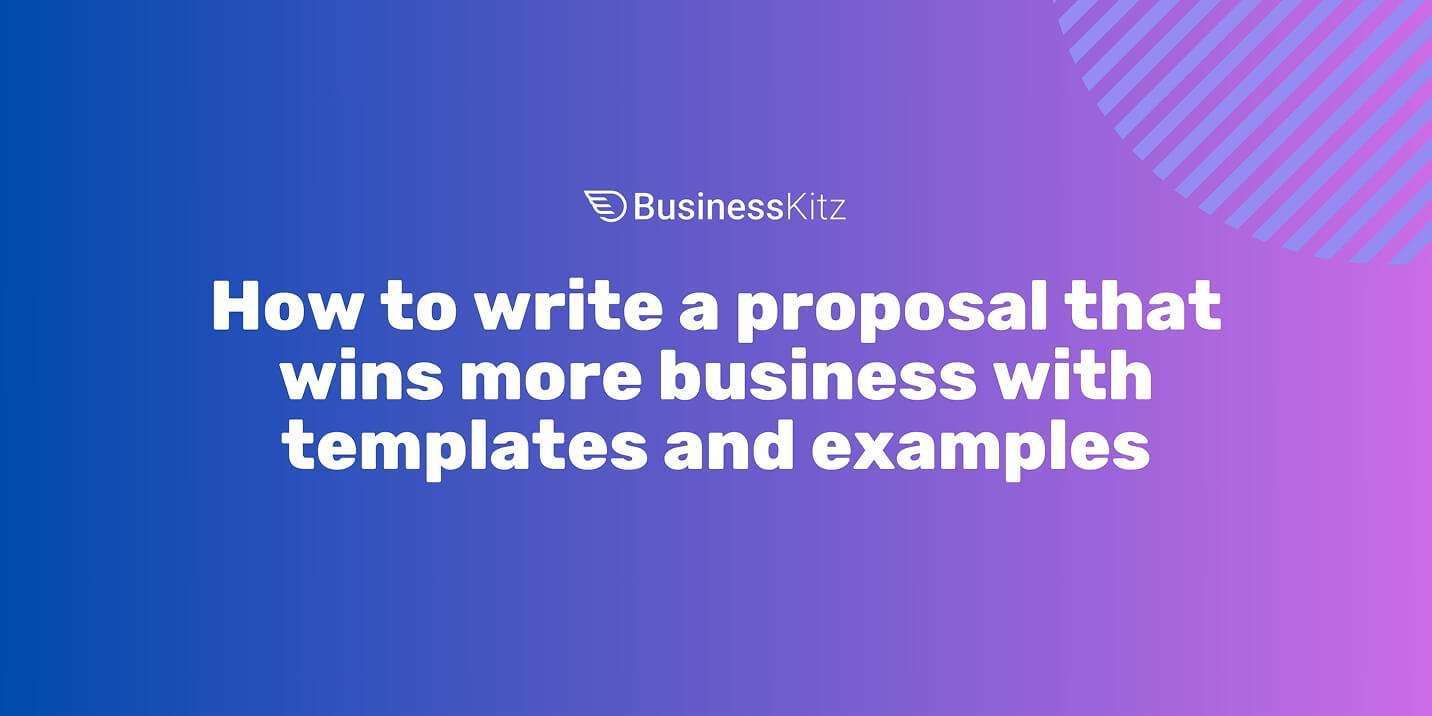
You've spent hours perfecting your pitch, but your proposal keeps getting overlooked—sound familiar? According to recent data, teams win only 45% of their RFPs on average, meaning more than half of all proposals fail to convert. The difference between winning and losing often comes down to how well you structure, present, and follow up on your proposal. Whether you're pitching a new project, seeking funding, or responding to a tender, mastering the art of proposal writing can transform your success rate. Let's dive into exactly how to write a proposal that not only gets read but gets approved.
We've helped businesses save $55m with our all-in-one platform. Get instant access to this template and 115+ others, plus AI-powered document creation, starting completely free.
A proposal is a formal document that outlines your solution to a specific problem or opportunity, presenting a clear plan of action with costs, timelines, and expected outcomes. Unlike casual pitches or informal conversations, proposals create a structured framework for decision-making that helps stakeholders evaluate your offer objectively.
The importance of proposals extends far beyond simple documentation. Research shows that entrepreneurs who write formal plans are 16% more likely to achieve viability than those who don't. This isn't just about impressing clients—it's about clarifying your own thinking and demonstrating professional competence.
In today's competitive business environment, proposals serve multiple critical functions:
Whether you're a freelancer pitching creative services or a corporation responding to government tenders, your proposal often represents the first serious commitment in a business relationship. It's your opportunity to stand out from competitors and prove you're the right choice for the job.
Understanding different proposal types helps you tailor your approach for maximum impact. Each format serves a unique purpose and requires specific elements to succeed.
Business proposals pitch products or services to potential clients, focusing on solving specific business challenges. These documents typically include company background, proposed solutions, pricing structures, and implementation timelines. They're essential for B2B sales, consulting engagements, and service agreements.
Project proposals outline everything stakeholders should know about a project, including objectives, methodology, resources needed, and success metrics. These internal or external documents secure approval and funding for new initiatives, making them crucial for project managers and team leaders.
Solicited proposals respond to specific requests (RFPs) where organisations actively seek solutions. These follow strict guidelines and compete directly against other submissions, requiring careful attention to stated requirements.
Unsolicited proposals present ideas proactively without a formal request. While there's no direct competition, you must work harder to capture attention and demonstrate relevance since the recipient isn't actively seeking solutions.
Grant proposals request funding from government agencies, foundations, or other funding bodies. They require extensive documentation of need, detailed budgets, and a clear demonstration of social or economic impact.
Academic and scientific proposals outline planned research projects, including hypotheses, methodologies, and expected contributions to knowledge. These documents undergo rigorous peer review and must demonstrate both originality and feasibility.

Creating a compelling proposal requires including specific elements that address client needs while showcasing your capabilities. Here's what every professional proposal must contain:
Your executive summary acts as a powerful introduction, capturing the essence of your proposal in one compelling page. Start by acknowledging the client's challenge, present your solution clearly, and highlight key benefits. This section often determines whether readers continue, so make every word count.
Demonstrate deep understanding of your client's pain points by articulating their challenges better than they can themselves. Use specific examples and data to show you've done your homework. This builds credibility and shows you're invested in their success, not just making a sale.
Present your solution as the logical answer to their identified problems. Break down your approach into clear phases or components, explaining how each element addresses specific challenges. Focus on outcomes and benefits rather than just listing features or services.
Provide a realistic project schedule with specific milestones and deliverables. Visual timelines work particularly well here, showing project phases, key dates, and dependencies. This demonstrates your project management capabilities and helps clients plan their own resources.
Present transparent pricing with detailed line items rather than lump sums. Include payment terms, potential additional costs, and what's specifically included or excluded. The average winning proposal keeps things concise—don't overwhelm with unnecessary financial detail.
Introduce key team members who'll work on the project, highlighting relevant experience and qualifications. Include brief bios, past successes, and why each person is perfectly suited for this project. Client testimonials or case studies add powerful social proof here.
Clearly outline project scope, intellectual property rights, confidentiality agreements, and cancellation policies. While necessary, keep legal language accessible and consider including a plain-English summary of key terms.
End with clear, specific actions for moving forward. Include acceptance instructions, contact information for questions, and a gentle reminder of your proposal's expiry date. Make saying "yes" as easy as possible.
Before typing a single word, invest time in understanding your client's industry, challenges, and competitive landscape. Review their website, annual reports, and recent news. Study their competitors and market position. This research forms the foundation of a proposal that truly resonates.
Connect with the client to clarify requirements and uncover unstated needs. Ask about their decision-making process, budget constraints, and success criteria. The more you understand their situation, the better you can position your solution.
Establish specific, measurable objectives that align with client goals. Rather than vague promises of "improving efficiency," commit to concrete outcomes like "reducing document processing time by 40% within three months."
Define project boundaries explicitly to prevent scope creep. List what's included and—equally important—what's not. This protects both parties and sets realistic expectations from the start.
Organise your proposal for easy navigation and quick comprehension. Use clear headings, short paragraphs, and bullet points to improve readability. Place your most compelling information early, as readers often skim proposals initially.
Create a logical flow that builds your case progressively. Start with their problems, present your solution, demonstrate your capability, then make the business case. Each section should naturally lead to the next.
Use simple, direct language that communicates value without jargon. Write in active voice and second person ("you" and "your") to maintain engagement. Keep sentences concise—aim for an average of 15-20 words.
Support all claims with evidence. Instead of saying you're "industry-leading," mention specific achievements or rankings. Use data, case studies, and testimonials to build credibility throughout your proposal.
Visual appeal matters more than many realise. Use consistent formatting, professional fonts, and your brand colours throughout. Include relevant images, charts, or infographics to break up text and illustrate complex concepts.
White space is your friend—don't cram every inch with text. A clean, uncluttered design suggests professionalism and makes your proposal more inviting to read.
Never send your first draft. Let it rest overnight, then review with fresh eyes. Check for typos, calculation errors, and formatting inconsistencies. Ensure your tone remains professional yet personable throughout.
Ask a colleague to review your proposal from the client's perspective. Do the benefits clearly outweigh the costs? Is the next step obvious? Would they feel confident choosing you based on this document alone?
A "we" proposal is a common slip-up in proposal writing. Clients care less about your company history and more about how you'll solve their specific problems. Flip the focus—for every statement about your capabilities, explain the direct benefit to them.
More isn't always better. Research shows the average winning proposal has only 7 sections spread across 11 pages. Respect your reader's time by including only essential information that moves your case forward.
Specificity sells. Replace "we offer great customer service" with "our dedicated account manager responds to all queries within 2 hours during business days." Concrete details build trust and set clear expectations.
Generic proposals rarely win. Thoroughly customise each submission to address the client's unique situation, using their language and reflecting their priorities. Show you've listened and understood, not just recycled a template.
Failing to highlight the client's return on investment leaves money on the table. Quantify value wherever possible—show how your solution pays for itself through increased revenue, reduced costs, or improved efficiency.
First impressions matter. Typos, inconsistent formatting, or amateur design can torpedo your credibility instantly. Invest in professional presentation—it signals you'll bring the same attention to detail to their project.
Tailor your language, examples, and benefits to resonate with specific reader roles. Technical decision-makers want different information from financial stakeholders. When possible, create sections addressing each audience's unique concerns.
Research the organisation's culture and communication style. Formal institutions expect traditional proposals, while startups might prefer a more innovative approach. Match their tone while maintaining professionalism.
Transform features into benefits by answering "so what?" after each capability statement. Instead of "we use advanced project management software," explain how this "ensures your project stays on schedule with real-time progress visibility."
Quantify value wherever possible using metrics relevant to their business. Percentages, time savings, and revenue impacts speak louder than subjective quality claims.
Break up text with relevant visuals that enhance understanding. Process diagrams, timelines, and comparison charts communicate complex information quickly. Ensure all visuals are high-quality and directly support your narrative.
Consider using subtle branding elements like colour accents or watermarks to maintain a professional presence without overwhelming the content.
Include genuine reasons to act quickly, such as team availability, seasonal considerations, or market conditions. Limited-time incentives can work if they're authentic and add real value.
Your proposal expiry date creates natural urgency while protecting you from price fluctuations. Most proposals remain valid for 30-60 days, giving clients reasonable decision time without indefinite commitment.
Remove friction from the acceptance process. Provide multiple ways to approve—digital signatures, email confirmation, or your document signing platform. Include clear instructions and ensure contact details are prominently displayed.
Consider offering a follow-up meeting to address questions. This shows confidence in your proposal while providing another opportunity to build relationships and overcome objections.

Modern businesses can't afford to waste time recreating proposals from scratch. Digital tools transform proposal creation from a time-consuming chore into a streamlined process. Teams using specialised software achieve higher win rates while reducing stress and saving valuable time.
Key advantages of digital proposal management include:
A scattered approach to proposal management costs more than just time—it risks your professional reputation. When proposals, contracts, and supporting documents live in different systems, mistakes multiply and opportunities disappear.
Business Kitz's document management features solve this challenge by centralising your entire proposal workflow. Store templates, track versions, and manage client communications from one secure platform. This integration means faster turnaround times and fewer errors—both crucial for winning more business.
The fastest route from proposal to project kicks off with electronic signatures. Remove the print-sign-scan bottleneck that delays projects and frustrates clients. Digital signing through integrated platforms reduces acceptance time from days to minutes.
When proposals flow seamlessly into signed contracts, you maintain momentum and demonstrate the efficiency clients can expect throughout your partnership. This professional approach often makes the difference between winning the deal and watching it stagnate.
Your first follow-up should arrive 2-3 days after sending the proposal. This confirms receipt and opens dialogue without appearing pushy. Simply ask if they've had a chance to review and whether any questions have arisen.
If silence continues, send a second follow-up after one week. Reference your proposal's expiry date and offer to schedule a brief call. This gentle reminder often prompts action from interested but busy prospects.
Keep follow-up messages brief and value-focused. Rather than "just checking in," provide additional insights related to their challenge or share relevant industry updates. This positions you as a valuable partner, not just another vendor.
Example follow-up structure:

Track proposal outcomes systematically to improve future success rates. When you win, understand why. When you lose, request feedback—most clients will share insights if asked professionally.
Document common objections, successful talking points, and pricing sweet spots. This data becomes invaluable for refining your proposal strategy and increasing win rates over time.
The ideal proposal length depends on complexity, but research shows winning proposals average just 11 pages with 7 sections. Focus on quality over quantity—include everything necessary to make your case, but nothing more. Simple services might need 3-5 pages, while complex projects could justify 15-20 pages.
Send your first follow-up 2-3 days after delivering the proposal. This confirms receipt and shows professionalism without seeming pushy. If you don't hear back, follow up again after one week, then transition to monthly check-ins unless they request otherwise.
Yes, always include pricing in your proposal unless specifically asked to omit it. Transparency builds trust and helps prospects make informed decisions. Present your pricing clearly with options if appropriate, but avoid overwhelming readers with too many choices.
Treat revision requests as positive engagement signals—they show genuine interest. Clarify specific changes needed, implement them promptly, and track versions carefully. Consider limiting free revisions to two rounds to protect your time while remaining flexible.
A quote provides specific pricing for defined products or services, usually in a simple format. A proposal is comprehensive, including background information, methodology, timelines, and terms beyond just pricing. Proposals sell your solution; quotes simply state costs.
Stand out by demonstrating deep understanding of client challenges, providing specific solutions rather than generic offerings, including relevant case studies, and presenting professionally. Focus on value and ROI rather than competing solely on price.
Use templates as your foundation for consistency and efficiency, but always customise content for each client. Templates ensure you include all necessary elements and maintain professional formatting while saving time for personalisation where it matters most.
Writing winning proposals doesn't have to be overwhelming. You now have the framework, best practices, and insider knowledge to create proposals that convert prospects into clients. Remember—successful proposals focus on client needs, demonstrate clear value, and make acceptance simple.
The difference between average and exceptional proposals often comes down to execution. While competitors struggle with scattered documents and inconsistent messaging, you can leverage modern tools to streamline your entire proposal workflow. Ready to revolutionise how you create, send, and track proposals?
Sign up for a free trial with Business Kitz and discover how our integrated document management and digital signing features can transform your proposal success rate today.
Copyright © 2025 Business Kitz 14312161